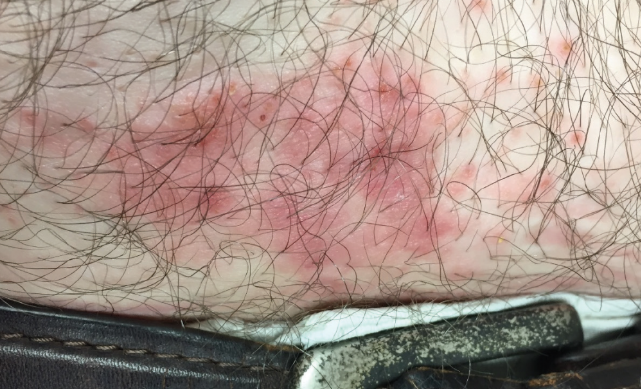Contact dermatitis is an inflammatory skin reaction that occurs in response to direct exposure to external irritants. ICD-10 codes: L23, L24, L25.
Irritant contact dermatitis (ICD) develops at the site of exposure to an irritant on the skin or mucous membranes, with the affected area corresponding to the area of exposure to the irritant. Acute ICD can occur in anyone, even after a single exposure to an irritating factor, if the intensity and duration are sufficient, especially in individuals with a predisposition. In the past, ICD was not associated with an immune response, but it is now established that the immune system plays a key role in resolving irritant reactions.
At least 10% of all visits to dermatologists are related to patients showing signs of contact dermatitis. Nearly 7% of occupational diseases involve skin damage due to exposure to irritants. Contact dermatitis is slightly more common in women due to their greater exposure to a variety of irritants (cosmetics, cleaning products, jewelry, etc.).
Allergic contact dermatitis (ACD) occurs in a sensitized organism. Involvement of the skin or mucous membranes extends beyond the site of exposure to the external irritant (allergen). Disseminated or even generalized rash patterns are possible. The inflammatory response in ACD is of the delayed hypersensitivity type and occurs 10-15 days after initial contact with the allergen. The concentration of the irritant (allergen), the area of exposure, and the route of entry into the body are not critical.Acute irritant contact dermatitis: Typically develops after a single contact with substances with strong irritant properties.
Chronic (cumulative) contact dermatitis: Develops after repeated contacts (over several months or even years) with substances having weaker irritating properties, including solutions (cleaning agents, organic solvents, soapy solutions, weak acids, and alkalis) or "dry" irritants (low humidity, powders, dust).
Allergic contact dermatitis: Results from sensitization of the immune system to specific allergens or multiple allergens, leading to the onset (or recurrence) of an inflammatory skin reaction.
The areas most commonly affected by irritants and allergens are the face, hands, neck, armpits, scalp, and less commonly the lower extremities, anogenital region, and earlobes.
Clinical manifestations of acute irritant and allergic contact dermatitis are similar and include erythema, swelling, bullous (ICD), vesicular (ACD) eruptions and fissures. Subjective symptoms include itching, burning and pain in the affected area. In ACD, eruptions may extend beyond the site of irritant exposure.
In chronic irritant contact dermatitis caused by prolonged exposure to irritants (even in low concentrations), the skin process is characterized by areas of subtle erythema, infiltration, cracking, excoriation and hyperpigmentation. After removal of the irritant, the pathological process may persist for months or years.- Atopic dermatitis
- Tinea corporis
- Psoriasis
- Seborrheic dermatitis
- Scabies
- Pityriasis rosea
- Mycosis fungoides
- Large-plaque Parapsoriasis
- Acrodermatitis enteropathica
- Porphyria cutanea tarda
Treatment goals - Regression of eruptions.
General remarks on therapy: In the case of contact dermatitis, the identification and elimination of the irritant have a significant priority.
If necessary, especially in the case of occupational exposure to irritants and allergens, adequate skin protection from chemical agents should be provided, such as protective clothing, properly fitted gloves (taking into account the specific irritant), protective creams, ointments, corn protectors and emollients.
For acute irritant contact dermatitis (ICD), topical anti-inflammatory agents and, depending on the clinical presentation, wet-dry compresses are often sufficient. Evidence for the efficacy of topical glucocorticosteroids for ICD is limited and results are conflicting. For allergic contact dermatitis (ACD), therapy usually starts with the use of medium- to high-potency glucocorticosteroid preparations. However, when ACD manifestations are localized to the face, eyelids, skin folds and flexural surfaces of the extremities, it may be appropriate to use low-potency glucocorticosteroid preparations.
Antihistamines may be used for severe itching.
Topical therapy:
- Fluticasone propionate, cream, 0.05%, applied thinly to affected skin areas 1-2 times a day for 2 weeks.
- Triamcinolone acetonide, ointment, 0.025%, 0.1%, applied thinly to affected skin areas 1-2 times a day for 2 weeks; therapy should start with the 0.1% concentration, then switch to the 0.025% concentration.
- Clobetasol propionate, ointment, 0.05%, applied thinly to affected skin areas 1-2 times a day for 3-4 weeks.
- Betamethasone valerate, cream, ointment, applied 1-3 times a day thinly to affected skin areas for 2 weeks.
- Mometasone furoate, cream, ointment, 0.1%, applied thinly to affected skin areas once a day for 2 weeks.
- Tacrolimus, cream, ointment, 0.1%, applied thinly to affected skin areas once a day for 2 weeks.
The course of contact dermatitis, although not frequent, may be complicated by secondary bacterial infection. In this case, topical application of antibacterial agents is recommended:
- Fusidic acid, cream, gel, 2%, applied thinly to affected skin areas 1-2 times a day for 1-2 weeks.
- Mupirocin, ointment, 2%, applied thinly to affected skin areas 2-3 times a day for 2 weeks.
Systemic therapy: If the extent of ACD involves more than 20% of the skin surface, systemic therapy with glucocorticosteroid preparations is indicated: prednisolone 0.5-1.0 mg per kg of body weight orally for 5-7 days, followed by gradual dose reduction until complete discontinuation.
Treatment results required: Regression of eruptions.
Treatment failure: In cases of refractory ACD, the use of immunosuppressive agents such as azathioprine and cyclosporine is possible. For chronic and recalcitrant ACD, phototherapy with UVB or PUVA therapy may be considered.
Prevention: Once contact dermatitis is confirmed, it is critical to eliminate contact with allergens, including those of occupational origin. Patients should be informed that the developed allergy is lifelong and even brief exposure to the allergen may lead to recurrence of the dermatitis.
